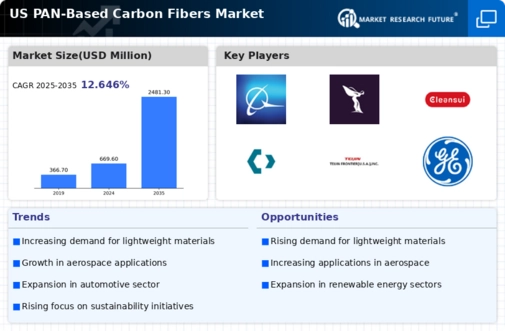The pan based carbon fibers market is characterized by a dynamic competitive landscape, driven by increasing demand across various sectors such as aerospace, automotive, and construction. Key players are actively engaging in strategies that emphasize innovation, sustainability, and regional expansion. For instance, Hexcel Corporation (US) has positioned itself as a leader in advanced composite materials, focusing on enhancing its production capabilities and expanding its product portfolio to meet the growing needs of the aerospace industry. Similarly, Toray Industries, Inc. (US) has been investing in research and development to innovate its carbon fiber technologies, thereby strengthening its market presence and operational efficiency.
The market structure appears moderately fragmented, with several players vying for market share. Companies are increasingly localizing manufacturing to optimize supply chains and reduce lead times. This tactic not only enhances operational efficiency but also allows for better responsiveness to regional market demands. The collective influence of these key players shapes a competitive environment where innovation and strategic partnerships are paramount.
In November 2025, SGL Carbon SE (Germany) announced a strategic partnership with a leading automotive manufacturer to develop lightweight carbon fiber components aimed at reducing vehicle weight and enhancing fuel efficiency. This collaboration underscores the growing trend towards sustainability in the automotive sector and highlights SGL Carbon's commitment to leveraging its expertise in carbon fiber technology to meet evolving industry standards.
In October 2025, Mitsubishi Chemical Corporation (Japan) unveiled a new production facility in the US dedicated to the manufacturing of high-performance carbon fibers. This investment is indicative of the company's strategy to bolster its production capacity and cater to the increasing demand from the aerospace and defense sectors. The establishment of this facility is expected to enhance Mitsubishi's competitive edge by ensuring a more localized supply chain and quicker delivery times.
In September 2025, Teijin Limited (Japan) launched a new line of eco-friendly carbon fibers made from recycled materials. This initiative aligns with the growing emphasis on sustainability within the industry and positions Teijin as a forward-thinking player committed to reducing environmental impact. The introduction of these products is likely to attract environmentally conscious consumers and businesses, further differentiating Teijin in a competitive market.
As of December 2025, current trends in the pan based carbon fibers market indicate a strong shift towards digitalization, sustainability, and the integration of AI technologies. Strategic alliances are increasingly shaping the competitive landscape, allowing companies to pool resources and expertise to drive innovation. The focus appears to be shifting from price-based competition to a more nuanced approach that prioritizes technological advancement, supply chain reliability, and sustainable practices. This evolution suggests that companies that can effectively differentiate themselves through innovation and strategic partnerships will likely thrive in the future.


















Leave a Comment